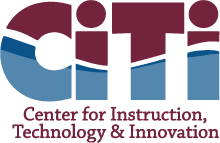CiTi Model Schools Recognizes Innovative New Science Tool at GRB
A computerized topographical mapping table is giving students at Fulton’s G. Ray Bodley High School an interactive and innovative look at everything from landforms and topography to climate change and erosion. The CiTi BOCES Instructional Technology Support (ITS) Model Schools has recognized the new tool as its program spotlight for the month.
The table is the brainchild of FCSD LAN technician Geoff Bertollini and technology teacher Nick Duvall. It looks much like a wooden cart on wheels but boasts a sizeable table of sand at waist-height. A frame holds a scanner system and digital projector several feet above the sand while a computer – the brains of the entire setup – rests below. The cart is large enough to accommodate several students at a time yet small enough to move in and out of GRB classrooms.
When used, the system scans the surface of the sand, measuring depths and sending that information back to the computer. The computer then projects colors and lines back onto the sand, clearly indicating their height and contours. The lowest elevations appear blue, then move through greens, yellows and oranges to snowy white at the tallest peaks. The result is a topographical mapping system that reacts in real time to any changes in the sand’s surface.
“It takes a lot of time and a lot of patience to get it right,” says Bertollini, who constructed the setup with Duvall over about two weeks. “But once it’s done, it’s great.”
Bertollini was eager to show off an exciting feature: When a hand is held above the sand with fingers outstretched, the computer recognizes the gesture and rains down simulated water, allowing observers to study the flow of liquids and note areas of greatest erosion.
“It screams STEM,” noted Bertollini. “And its fun to play with. I have a projector at home and I might build one for my kids.”
In the classroom, the results have been immediate. Shana Severance and Jacob Lohr, both earth science teachers at GRB, have been using the tool since its creation late last fall. With great student support, the pair have used the table to demonstrate topographic mapping, water erosion and deposition, gradient and isolines, landscapes and relative dating.
“It can definitely be integrated into a lot of lessons,” Severance said. “Plus, the kids have a ball.”
Lohr agreed. “It lets them learn the concepts a lot easier when they can see something hands-on and physically change it themselves. They get to watch it happen in front of their eyes.”
Both the designers and the current users hope to see teachers from other departments begin to incorporate the tool into their own lessons. “There’s so much this can do for earth science,” said Bertollini, “but there’s also so many possibilities for technology, engineering, and even social studies.”
Bertollini and Duvall look forward to continuing to perfect their design and hope that it continues to promote and assist student learning and innovation.







